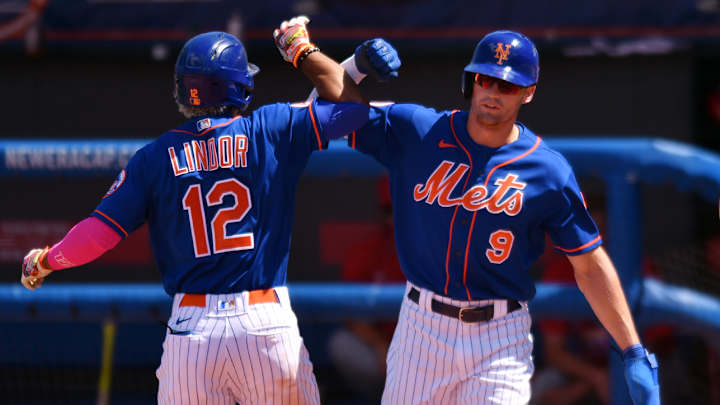Even With ‘Steve Cohen Tax,’ Mets Leaders Are Grateful to Be Back

PORT ST. LUCIE, Fla. — In some ways, the Mets reported to spring training against their will this weekend. Their three players on the Players Association board—righty Max Scherzer and shortstop Francisco Lindor, of the executive subcommittee, and outfielder Brandon Nimmo, the team representative—each voted no on the owners’ Thursday proposal for a new collective-bargaining agreement. But 26 of the other 35 union leaders voted yes, so both sides ratified the document and camps opened on Friday.
So, some 42 hours into labor peace, Scherzer, who has become the face of the union, and Nimmo, who polled his teammates and said he found them “on the same page,” addressed why they were willing to let the owner-imposed lockout drag beyond Day 99. One of the provisions they had most opposed is an additional penalty on spending above $290 million, which people around the industry believe is aimed at the Mets’ deep-pocketed owner.
“The Steve Cohen tax?” Nimmo said. “Obviously I'm not a huge fan, because that's Steve's tax, basically. But it's something that [the other owners] were passionate about, and they wanted. That was one thing that we weren’t totally for, but I get it, I guess. Obviously, being underneath Steve, I’m not gonna lie and be like, ‘Oh, yeah, I was all for that.’ Definitely didn't want to limit him from spending the money that he has to spend the way he wants, but it is what it is. In the deal-making process, you gotta concede some things, and our majority felt like that was the right decision.”
Nimmo has been in the organization since New York took him in the first round of the 2011 draft, back in the days when former owner Fred Wilpon was struggling to make payroll after Bernie Madoff’s Ponzi scheme—in which Wilpon was heavily invested—went under. At one point that year, the highest-paid player on the team was former third baseman Bobby Bonilla, who had been retired for a decade and was receiving $1.2 million annually in deferred money.
So when billionaire hedge fund manager Cohen bought the team in 2020, the players grew hopeful he would pour money into it. This is the man, after all, who in ’15 had purchased Alberto Giacometti’s 1947 bronze sculpture “L’Homme au Doigt” (“Man Pointing”) for $141.3 million—more than the Mets had ever shelled out for any player. (Until the team signed Lindor to a 10-year, $341 million extension last April, the record was former third baseman David Wright’s eight-year, $138 million pact.)
From Nimmo’s perspective, the Mets finally got a guy who would spend money, and because he is something like twice as rich as many other owners, his peers reined him in. “There’s a level of frustration with that, no doubt,” said Nimmo. “You have a guy come in like Steve and he wants to win as badly as he does and you’re passionate about that—it does frustrate you a little bit.”
The tax may not be as onerous as the Mets believe it is. The 80% penalty would only apply to money spent over $290 million. And Cohen, who the team said was unavailable for comment on Saturday, has expressed a willingness to spend: Their payroll is already expected to be around $267 million, nearly $37 million over the first threshold, and Scherzer, who signed with New York hours before the lockout took effect, will make $43 million in each of the next three years, the richest contract ever by average annual value.
Scherzer himself, perhaps the player most educated on the ins and outs of the deal, was less interested in discussing why he wanted to reject it. “We can talk about the pros and cons at a later time,” he said. “You gotta realize, we got baseball back. The fans want to hear us talk about baseball.”
If he harbors any hard feelings that the rest of the union did not share his concerns, he kept it to himself. Instead he joked about having salad dressing on his face and trash-talked the hitting ability of pitching coach Jeremy Hefner, who stood in the batter’s box during Scherzer’s bullpen session. Scherzer was willing only to discuss his own experience in union leadership.
“The Xs and Os of the proposals and everything, I enjoyed being on the front lines for that,” he said. “The hardest part was the amount of phone calls that I had to make and be in connection with everybody across the game to try to get that information out.” He added that he was “happy I get my life back.”
And, even though he wanted to keep pushing, he said he celebrated an end to the months of fighting. Once it was official, Scherzer said, smiling, “I drank a lot.”
More MLB Coverage:
• The Battle for Baseball’s Soul Continues
• Three Things to Watch for As Baseball Returns
• The MLB Lockout Is Over. Now the Chaos Begins.
• Baseball Avoids Disaster Just in Time for a Fresh Start

Stephanie Apstein is a senior writer covering baseball and Olympic sports for Sports Illustrated, where she started as an intern in 2011. She has covered 10 World Series and three Olympics, and is a frequent contributor to SportsNet New York's Baseball Night in New York. Apstein has twice won top honors from the Associated Press Sports Editors, and her work has been included in the Best American Sports Writing book series. A member of the Baseball Writers Association of America who serves as its New York chapter vice chair, she graduated from Trinity College with a bachelor's in French and Italian, and has a master's in journalism from Columbia University.
Follow stephapstein